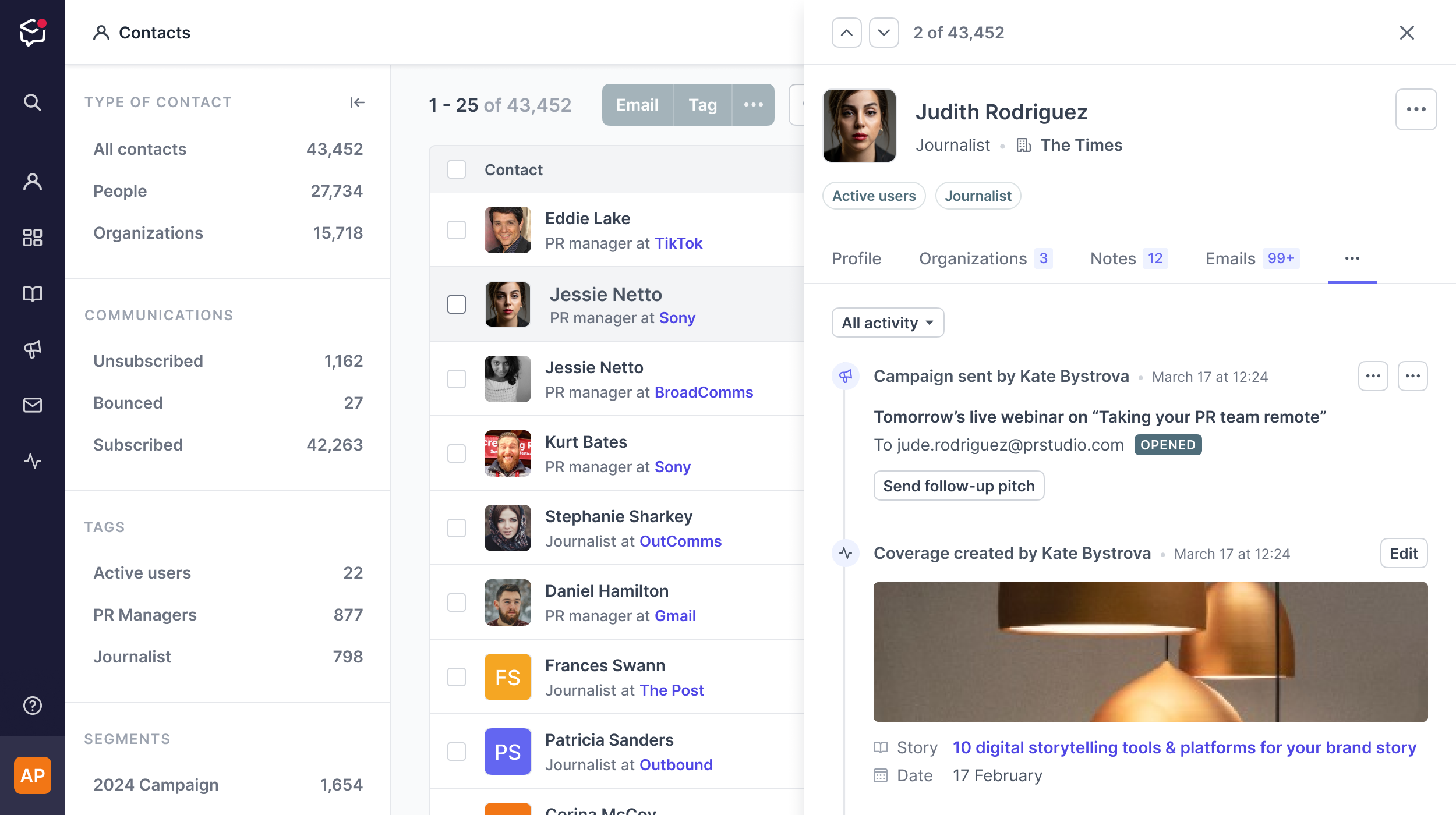What are the different distribution channels I can use for my press release?
How to get the most out of your shiny new press release
Okay, you wrote a press release. You (or your favorite PR AI) finalized the masterpiece, ran it through a spell-checker, and are ready to share it with the world.
But how?
What are the most effective ways to get your PR to the people? And not just any people. The best people.
Let's discuss the finest distribution channels for your press release.
Try Prezly for free todayWe've written previously about newswires and their tenuous grasp on public relations as a whole. Some industries and journalists still utilize newswires and newswire digests when finding stories to publish. However, PR newswires have long been going out of fashion and have been eclipsed by, basically, the entire internet.
We spoke with some extremely clever people from all walks of PR, from in-house lifestyle brands to gaming PR agencies. The consensus? PR newswires can still play a role in your press release distribution, it just shouldn't be a main one.
Ok, quick recap: what is a newswire?
A newswire is a service where, for a fee, businesses and public relations teams can upload their press release and have it seen by anyone who happens to be looking for press releases. This used to be a convenient, timely way for journalists to find stories in their niche.
That was before the entire world and their grandma started to throw every non-story they had onto any newswire they could find in the hopes of coverage, in most cases with zero regulation. The result? Newswires have become a cesspit of press releases with zero quality control, making them less of a useful media resource and more of if hell had a Craigslist.
Add to that the shrinking number of journalists, growing number of stories and the accessibility of the internet to hunt down anyone anytime, and the reality is that most of the time, journalists don't have to spend a ton of time seeking out stories; stories come to them.
Between this shift in media relations and the high costs of newswires, no wonder PR folks are turning away from newswires in pursuit of more modern distribution methods.

Pros of newswires:
- Easy, plug-and-play distribution
- Can be personalized by niche
- Are still used by some journalists, especially in certain industries (business and finance, predominantly)
- Can be useful for distributing smaller generic stories
Cons of newswires:
- Expensive
- Limited formatting
- Easy to get drowned out in the noise
- Not great if you're looking for a feature
- Did we mention expensive?
The final verdict: Newswires are fine if you have an unlimited budget and low expectations.
Email has become the de facto PR distribution method. It's inexpensive and, paired with solid contact management software, can be targeted toward a select number of people who (hopefully) want your content.
Unlike newswires, which very much fall into the "pay and spray" (or "pay and spray and pray") bucket of distribution methodology, email allows you to get the message directly to the journalists and media publications that can best distribute your message.
That is, if you use email correctly.
Pitch journalists right now with a 14-day free trial
- Identify your most engaged contacts with our PR CRM
- Send personalized email pitches and campaigns
- Publish your press releases in a professional newsroom

The ability to connect with journalists has been used and abused in the last few years. Instead of sending carefully crafted pitches, some PR and marketing folks are choosing to send generic pitches to everyone, which really does a disservice to everybody. It wastes time, hurts brand credibility, and damages media relations (not to mention is likely to get you blacklisted by email clients).
As a former columnist for The New York Times it pained me to get press releases from high-priced agencies that were completely off topic. In a few instances I forwarded the press release to the business owner so that they’d become aware of how their money was being wasted and brand name was being diminished.
Like Uncle Ben said, "with great [email addresses] comes great responsibility [to not be annoying]."
Email can be an incredibly ineffective tool for PR distribution if you use it as a way to spam your PR to anyone and everyone with an email address. The key to a great email strategy is personalization and targeting (aka not buying media lists).
My most effective technique for sending out press releases is personalized emails and correspondence directly to the journalist or reporter. The open rate and percentage of coverage for my clients is higher when I'm able to personalize the release and tailor the pitch to the journalist singularly.
As far as technique, I will often reach out to the journalist on LinkedIn or through Instagram DM's to let them know that a pitch is coming their way that I believe is in alignment with the beat that they cover. Once the press release is sent their way, I then follow-up to let them know that is in their inbox ready for their review. Those mini touch-ups has also increased the chances for my clients and their coverage.
But wait! Before you start emailing willy-nilly, take a gander at these helpful guides to make your pitch perfect:
- 5 things editors want you to know about your media pitch
- How to do PR outreach (and 10 garbage fire mistakes to avoid)
Pros of email PR distribution:
- Free options available
- Paid options give you extra features such as personalization and CRM integration
- Highly customizable
- Can be fantastic as part of a great strategy
Cons of email PR distribution:
- Easy to abuse if you aren't careful
- Pretty saturated as a method of cold-contacting media contacts
- Can land you in spam folders if done incorrectly
The final verdict: Email is probably the best method when done right and the most useless method when done wrong.
A full PR toolkit at a fraction of the cost
Prezly’s PR CRM, Outreach, Newsroom Creator, Media Monitoring and Analytics earn you authentic media coverage by putting journalist relationships first. Starting at $90/month.

Okay, this is a weird one. Traditional press releases may not seem to lend themselves flawlessly to social media. Mergers and acquisitions, financial updates, and other technical mumbo-jumbo will probably not delight the average Instagram user.
However, there are plenty of press releases that would actually be quite interesting as a social media press release.
For example, if you are a fashion brand and your PR is about releasing a new line? Your audience will love that. But, if you're a fashion brand and your PR is about your fourth-quarter financial statements? Maybe skip that post. Use the press release to tell your fashion brand story.
It's all about the audience. What will engage real people and advance the brand messaging in non-lame and boring ways?
We tend to use a combination of email for local media outlets and social media, especially Twitter, for wider reach. We can often circumvent the press corps by posting big updates directly to multiple social media channels, where the information will reach our customers, partners, and competitors quickly enough.
Pros of using social media for PR:
- Free or free-adjacent
- Direct to your fans (great for consumer brands in particular)
- Opportunity for playful and creative messaging
Cons of using social media for PR:
- Can be weird if the press release is not of interest to the consumer
- Social media algorithms are not always your friend
- Depends entirely on your industry and audience
The final verdict: Whether social media will be a successful PR distribution method for your brand is super dependent on your industry, story, and overall approach.
Shockingly, some people are still using physical mail to send their press releases. Yes, actual paper mail. The thing from the emoji. ✉️
But who are we to argue? If people find it useful, then there you go. We at Prezly haven't sent or received a physical letter in several decades that wasn't a bill.
That being said, there are incredibly clever ways to use physical mail to get your news out there, as evidenced by this super clever lawn care company:
When we need to launch our service in a new market, it is crucial for us to get local media coverage. Without a mention in the local newspaper or on a local television news station, it's very difficult for us to gain traction in that new market therefore our press releases are very important. With these reporters and tv personalities getting so many emails and phone calls, we knew we had to do something out of the ordinary. When looking for the proper contact to email, almost all reporters have a bio about themselves. Favorite restaurants, hobbies, and even pets. What we did was to find the ones that mentioned they had a pet and sent them a dog bone in the mail to the news station--with a card attached discussing our upcoming launch and then I follow up with an email referencing the bone. This got a few reporters' attention and led to our first free PR hit. This little technique has now accounted for over 150 mentions and counting in the local media. It's unorthodox but very personal and set's us apart.
If that isn't the most delightful idea!
Thinking outside the box in the age of mass spamming and depersonalization is almost always worth the extra time and effort. This is especially true if your distribution is local and/or targeted or if you're looking to get coverage for a physical product, such as if you run PR for beauty brands. Sending a product or sample is a great way to get featured without the friction of the back-and-forth of coordinating sending the item. Just send it! If they try it and love it, cool. If they put it on a shelf and forget you exist for the rest of eternity, also cool.
Pros of using physical mail for PR distribution:
- Uncommon so sets you apart
- Can be very effective for local PR
- Targeted
Cons of using physical mail for PR distribution:
- More pricey and time-consuming
- Likely extremely ineffective for global/digital campaigns
- Potentially horrible for the environment, e.g. if you print your message on plastic bricks that you mail internationally
- Requires buying stamps (yuck)
The final verdict: You have to be extremely strategic about physical mail campaigns, and realistically they will only be successful in very specific cases.
Your press releases should absolutely live on your company site or in a dedicated online PR newsroom. If you're relying on PDFs, social media posts, newswires and the like to be the only source of finding your press release, you're going to have a bad time.
Creating an online newsroom or press room is great because:
- Your press release can be updated with new information in real-time
- You can have a permanent link for sharing
- Your PR will add SEO value
- You can include images, videos, soundbites, quotes, PDFs, and so much more (i.e. a digital press kit)
Your website, however, should not be your only distribution method. Why? Because who is routinely going to individual brand websites for updates about their company? People haven't got the time to be refreshing your corporate website. There are simply too many memes to consume for that sort of vigilance.
The least effective method of sending out a press release is posting it only to the company's website. This limits the opportunities that may arise from distributing news to a broader audience.
Pros of using the company website for PR distribution:
- An important part of any distribution strategy
- Can be combined effectively with email PR distribution
- Customizable, evergreen
- Can create permanent links for easy distribution
- Adds SEO value to your site
- Demonstrates the "history" of the brand
Cons of using the company website for PR distribution:
- It's not a complete distribution strategy on its own
- Requires initial setup
- End of list, everyone should have a company website
The final verdict: There's really no downside to publishing your press releases on your company website or your online newsroom. There are tons of newsroom software options available if you need any of your content to stay private or be scheduled under embargo.
Okay, this non-answer is going to annoy the majority of the people reading this, but the best PR distribution channel is: a strategic combination of them all. This is 2025, you can do multiple things at once, and you absolutely should (or get ChatGPT to do them for you 👀 ).
Want to send an email? Perfect. Send a dog bone? By all means! Make a… press release TikTok? Why not?! If Duolingo can be absolutely feral on the app, you can too.

PR distribution today is easier than ever, which creates its own problem because competition is fierce. So use your lumpy brain to come up with clever, creative, non-annoying, interesting, and targeted distribution for your PR.
Don't get locked into one type of distribution, and have fun with it.
One thing is for certain, though. You absolutely need an online home for your press release. If you're looking for a fantastic way to create beautiful newsrooms (you can check these gaming newsrooms out for inspiration), professional press releases, and awesome email campaigns with all the analytics, look no further than Prezly! Can I tempt you into a completely obligation-free, no-CC-required, 14-day free trial?
Prezly – software for modern PR teams
Write & publish brand stories in an online newsroom
Send email campaigns, pitches & newsletters
Manage all your contacts in a single CRM, with easy import & export
Measure performance with analytics & built-in media monitoring

Ready to start growing your media reach?
With Prezly you can publish press releases online, and share them directly with journalists. 14-day free trial, no credit card required.



